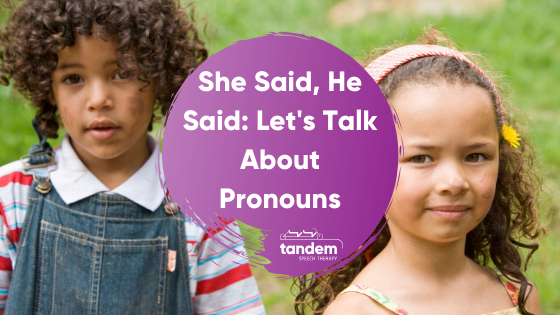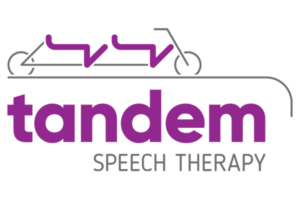
We have all had a child or student say something such as, “me want to play” or “her did it.” At some ages, that can be appropriate and even cute, but at the age of 4 or 5, that’s not the case. I have been working on use of pronouns a lot with my preschool-aged speech therapy kids. It’s been challenging for both me and for them.
To get myself started, in better supporting my clients, I had to refresh my memory. A pronoun is defined as a word that takes the place of a noun. There are different types of pronouns, but for purposes of early language development, we’ll stick to the basics. Personal pronouns include I, you, he, she, it, we, and they. Possessive pronouns include my, your, his, her, their, and its. The research varies slightly concerning pronoun acquisition; however, all research agrees that I and it are the first to emerge, followed by you.
Now comes the tough part…teaching pronouns. Particularly for our children with auditory processing issues, a language delay, or those who use echolalia. Pronouns by nature are abstract which makes them more difficult to “see” and therefore may be challenging to teach. Often I work with kids who can identify people as male or female–an essential piece of the puzzle for building correct pronoun use. But repeatedly they will replace ‘her’ when they should use ‘she’ or ‘they’ when the child should say ‘them.’
I find myself working on the pronouns she and he most often. Here are some of my tips for teaching children to use this pronoun pair correctly. And because I like to work on concepts in play, let’s get started by Playing With Purpose:
1. I make sure to have toys that lend themselves to he/she and I begin by modeling phrases in play for the child to hear. I love using my Little People house for this play routine. For example, I might say, “the boy is sitting” as I have the boy character sitting at the table in a chair. Notice how the word boy is emphasized here. I overemphasize it when I produce my sentences while teaching the concept since I want to draw the child’s attention to the words. During this initial phase, we are simply modeling and not expecting the child to repeat anything back. In this example, I might even say, “the boy is driving. He is a boy,” so that the child starts to understand the connection between the words boy and he.
2. Next, we want the child to be able to point to identify that they know and understand he/she. So I might say, “show me, she is swinging” and wait to see if the child points to the girl character that is in the swing. If the child is not successful when you have many toys playing in the house, you can narrow the choices to 2 and see if that helps. Another option is pointing to the girl on the swing while saying, “show me, she is swinging” and then waiting for the child to point to the same thing.
3. Then, we want your child to repeat back the models you produce. You want to make sure that he is for a boy and she is for a girl. As you are playing with the house or your child’s favorite action figures, begin to make references such as “Wonder Woman is a girl. She is running,” or “Iron Man is a boy; he is driving.” Pause and allow your child to imitate your phrases. Be sure to follow up with specific praise. I would say, “I like how you used she when talking about your Wonder Woman.”
Ultimately, we want your child to have enough practice through repetition and modeling that they start to correctly and spontaneously use the pronouns in their everyday language. Repetition is the key to acquiring new skills!
Other Tips for Teaching Pronouns:
1. Pair pronouns with gestures. The gesture provides a great non-verbal cue for the child to understand who you are referring to and what each pronoun represents. Point to yourself for “I” and tap your child’s chest for “you.”
2. Use your typical play routines and interactions for teaching pronouns. Model, gesture/point and emphasize the pronoun by raising your pitch, intonation, and volume. Provide lots of opportunities for repetition and practice.
3. Give a model of how the child should say it. Rather than saying, “Do you need me to help you?” prompt your child with a model of what they should be saying. So, for example, you would model, “Help me.”
4. If your child misuses their pronouns, repeat a corrected phrase to them. Then wait for them to imitate it back to you. For example, if your child says “him eating” while playing with the toy house, then you would say, “yes, he is eating.” If your child does not imitate, that is ok. Find a few other opportunities to model the phrase and keep on Playing With Purpose.
Start Playing With Purpose
Learn how to purposefully and intentionally interact with your child during play and help them increase opportunities for speech and language development with our Playing with Purpose book!











